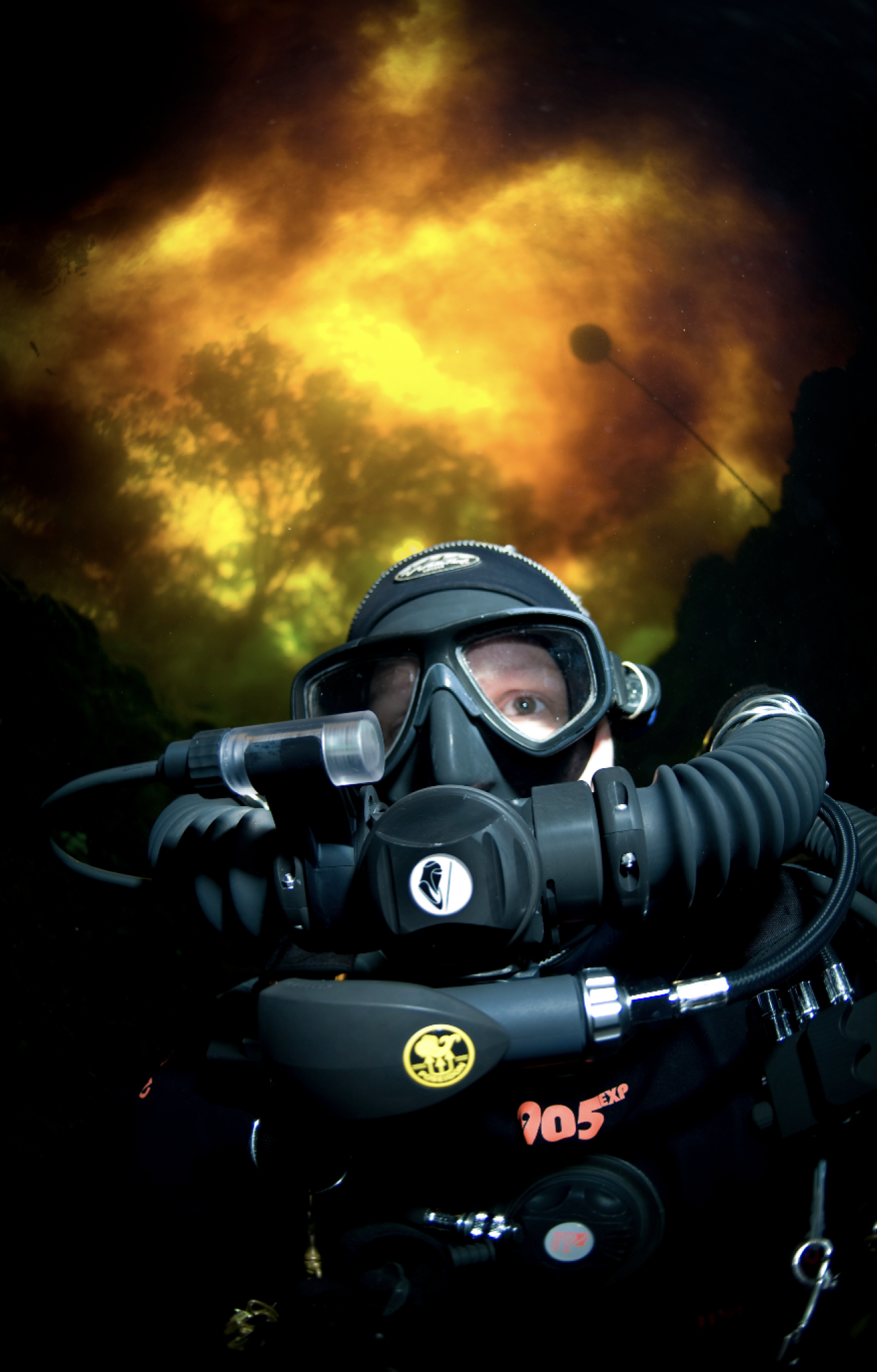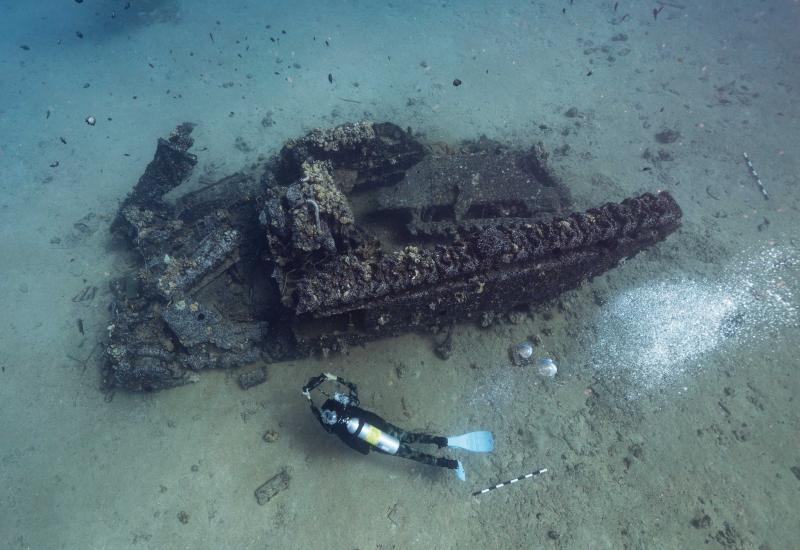How Diving Helps You Face Your Fears
Fear: that “prickles on the back of your neck,” heart-racing sensation often accompanied by a strong urge to flee. We’ve all felt it. Maybe in a dark parking garage or when gearing up for that first-ever night dive. We generally try to avoid the feeling, but fear can be a powerful driver if we welcome it.
People who push the limits of what’s possible are often called fearless. They’re the ones taking risks by swimming into unknown cave passages and putting it all on the line in the pursuit of pushing human bounds. But these explorers are the first to admit that they, too, feel fear, but they choose to embrace and overcome it rather than fold under its weight. Here are their tips for finding courage in the face of fear.
Extended interviews witch each of the featured explorers can be found below.

Jill HeinerthAs a part of the Bermuda Deep Caves Project, Heinerth made waves by joining the deepest dive in the island’s history.
Jill Heinerth
BIO: Canadian explorer Jill Heinerth is a cave and rebreather diving pioneer and member of the International Scuba Diving Hall of Fame. She’s explored uncharted icebergs and filmed breathtaking underwater worlds. A passionate advocate, she inspires ocean conservation through photography, film and exploration. Her new film, Diving Into the Darkness, explores her life and trials as an explorer. She recognizes that fear is something that should be managed, not eliminated completely.
Related Reading: How to Conquer Your Fear of Night Diving
JILL’S LIFE MOTTO: Love one another.

Jill Heinerth
When I stop being scared, I should hang up my fins. I want to dive with others who have a healthy fear too. When we feel a bit of fear it means that we care about the outcome of our choices. The important thing is to deal with those fears before descending. Whenever something startles me, I immediately feel my pulse rise and respiration increase.
My mind explodes into a cacophony, like a bunch of chattering monkeys all speaking at once. But fear isn’t always presented in a startling way.
Fear is also dread or discomfort and something that brings unease. In either case, I combat those feelings with a deep, cleansing breath. As I inhale, I tell myself to leave the emotions behind. I calm the nerves and prepare myself to move forward with pragmatic, small, organized steps that lead to success.
One of the most empowering things someone can do is take a freediving course and learn to breathe effectively. Breathwork is life-changing and taps into powers that you did not know you had."
Be part of the club! Keep up to date with the latest in diving and underwater adventure. Join PADI Club today for access to exclusive events, dive meet ups and a subscription to Scuba Diving magazine.
Beatrice Rivoira
BIO: Beatrice Rivoira is an accomplished marine biologist, author, dive safety officer and scientific diver based in Abu Dhabi, United Arab Emirates. As a tec instructor and cave diver, she helps marine scientists find new instruments and protocols for their research projects.
Her exploration work has included archaeological and biological underwater projects, and she has a special interest in human factors and risk management in diving.

Silvano BarboniPortrait of Beatrice Rivoira.
One of my instructors once told me: ‘Never do a dive that you wouldn’t do alone’ (excluding training dives). This doesn’t just mean you can go along with the dive; it means that you are on the spot.
You need to be prepared to face whatever the dive brings, so that if something happens, you’re not relying on anybody else to do something—you’re ready to take action.
To train your mind to conquer fear, you need to try to create situations where you can experience fear in a safe way. So, you may need to do it with a person that you really, really trust, in a controlled environment, so that you get accustomed to it. It doesn’t mean that it’s going to go away. But if you get accustomed to that feeling you can slowly build up space to react even if you’re afraid.

Gatien CosendeyRivoira spots an old cart used for hauling materials in a now-flooded Swedish mine.
BEATRICE’S LIFE MOTTO: Just enjoy life, do the best you can, and treat others the way you want to be treated.
A process that helps me a lot is visualization. I find a quiet place, a quiet moment, and I just go through everything that I’m about to do, starting from moment zero. At some point, you get enough experience to start visualizing things because you get an idea of how things could be. And when you know yourself, you also know if something would feel uncomfortable for you or not."
Cristina Zenato
Cristina Zenato is an Italian explorer based on Grand Bahama Island. A passionate shark advocate and conservationist, Cristina works to change the public perception of sharks. She is an active tec instructor and cave explorer and was the first woman to connect a freshwater cave with the ocean, unlocking an understanding of how Earth’s water systems are connected. She fights for the conservation of cave systems through her mapping and expedition work and through public speaking. When in doubt, she trusts her gut.

Kewin LorenzenPortrait of Cristina Zenato.
Feeling a little bit nervous before a dive is OK because it is going to cause a bit of adrenaline and focus, but there’s a huge difference between that and a gut feeling that says, “No, no, no, stop it right now.” And you have to learn how to follow that.
When you can acknowledge it—that anxiety and fear—you can get a better analysis of it and where it is coming from. It’s when you ignore that gut feeling, due to peer pressure or time pressure, that you can get into trouble. The first thing to do to overcome fear is to understand what triggers it.
Some fears come from accumulated experiences that we try to ignore. So if a fear is hindering you, it’s time to open that box and go through it and say, ‘What is it really that I am afraid of? What is the deepest thing?’ Then, slowly chip away at it. Do research, read and talk to other people who manifest the opposite of your fear.

Kewin LorenzenZenato spends so much time with Caribbean reef sharks, many have become familiar with her.
Cristina’s Life Motto: Deal with it. When things come, don’t run away.
“At this stage of my career, I can recognize where and how fear sits, when to listen to it and when to review it a little bit. When we cave dive and explore, we know that there is a possibility of death, but the presence of death should not stop us from pursuing exploration. The fact I know death is a possibility is what allows me to say, ‘You know what? Not today.’ Not because I’m fearful, but because I know that I need to get out so that I can have another day to keep doing what I do.”
Nathalie Lasselin
BIO: Nathalie Lasselin is an underwater filmmaker, tec instructor and explorer who studies the relationship between humans, our well-being and the environment. In 2018, she spent 30 hours underwater in the St. Lawrence River, traversing the island of Montreal from one end to the other. She dived 44 miles of the river and ate, drank and slept underwater.
Her work has brought awareness to the importance of freshwater ecosystem preservation and clean drinking water. While on filming assignments, she has dived to depths of more than 400 feet in caves, explored shipwrecks and dived under ice in the Arctic. Here are her tips on conquering fear.

Julien BourquePortrait of Nathalie Lasselin.
There are two kinds of fear: real fear and fear that doesn’t belong to us. Sometimes, fear can come from childhood or someone else. Maybe someone is just transmitting their fear to us, but it has nothing to do with us. Real fear is trying to prevent us from being in a bad situation, and we need to be really humble about what we can do and what we can’t do.
Nathalie’s Life Motto: Life is charming, depending on the lens through which you view it.
Maybe we are not ready, or we don’t have what it takes at that moment. Maybe later on we will have what it takes. It’s really important for me to make the difference between those two kinds of fears, because sometimes it’s just understanding that we’re taking on fears that don’t belong to us, and we need to let them go. So, it is important to listen to the fears, talk to them as if they were a person and even reassure them sometimes.
Fear is something I do not avoid talking about with my students and buddies. I put everything on the table. Most of the time when I’ve got fear that might stop me from doing something, I’m like, ‘I’m going to try it.’ You’ve got two options. Either your fears stop you from doing stuff that could be amazing, or you try to overcome them. And worst-case scenario, you say, ‘Well, I did it. It was OK, but I don’t want to do it another time.’ Or you’re like, ‘Wow, it was so amazing.’

Nathalie LasselinLasselin and a team of divers pose with an array of diving gear during a 2023 expedition to Manicouagan Crater.
When I started cave diving, I did an interview with a cave diver, Jim Bowden, who set a world record for deep diving in 1994. He told me: ‘Never change your rhythm of breathing. Control it; don’t let your breathing control you,’ meaning don’t let your emotions control you. And for me, that was really great advice.”









